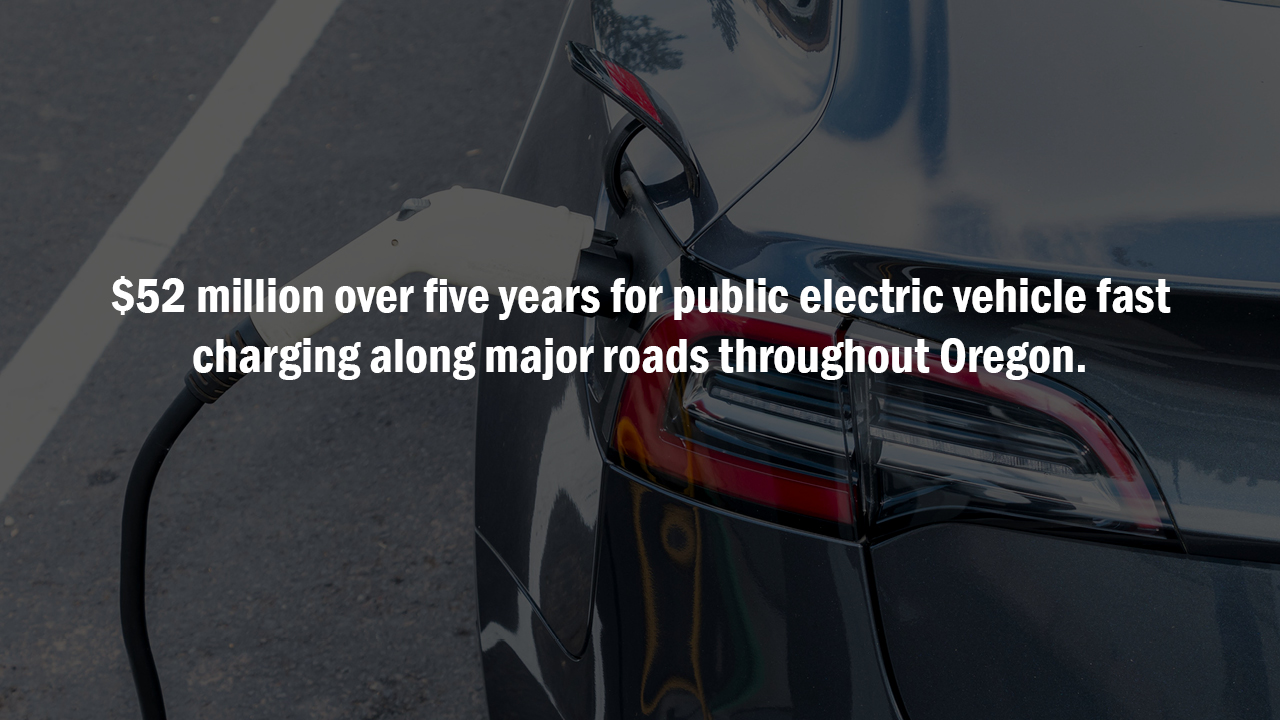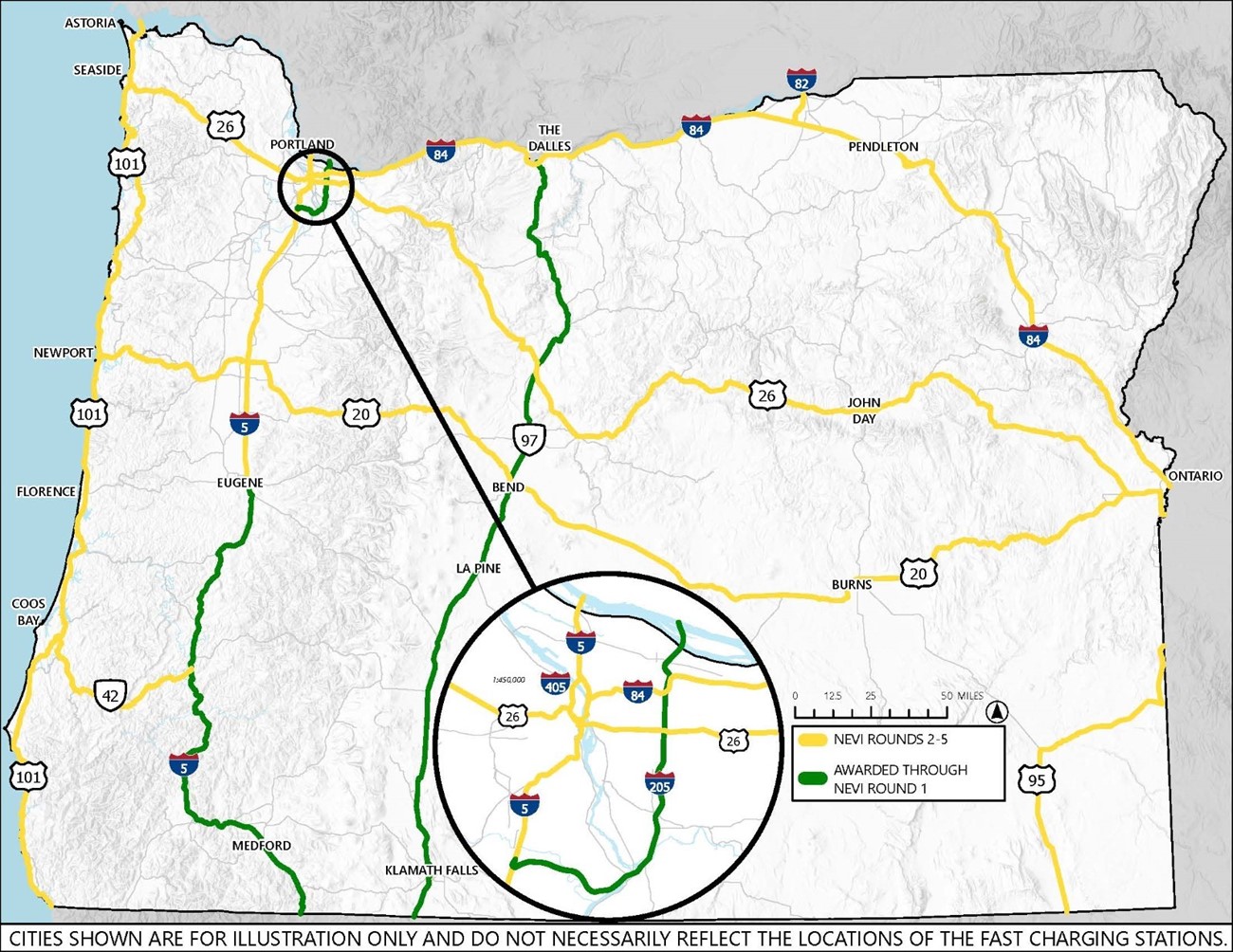
Latest updates - December 2025
- ODOT received several questions in response to the Notice of Funding Opportunity and has published an updated FAQ in response.
-
We issued a Notice of Funding Opportunity for the Round 2 NEVI work on
I-84,
U.S. 20,
U.S. 26,
U.S. 101, and
U.S. 97 on
Nov. 21, 2025. Applications are due
Feb. 20, 2026.
- In total, we plan to fund about 40 DC fast charging stations in Round 2.
- We have obligated (secured) all federal funding necessary for the construction of NEVI compliant DC fast charging stations along these roads, $32.3 million in total.
- We have made several changes to the program since Round 1, including:
-
Removing the pre-qualification step: We removed a pre-qualification requirement for applicants, which should encourage a larger applicant pool.
-
New individual charging station option: We added the option for EV charging companies to develop individual charging stations along a road, instead of requiring one company to develop all charging stations along a road. Details are included in the NOFO linked below.
-
More flexibility in station locations: Earlier this year the federal government removed the requirement for NEVI stations to be located 50 miles apart and within one mile of the road. This change will give EV charging companies more flexibility on where to locate the final stations to best serve EV drivers.
-
Expansion of the eligible applicant criteria: In Round 1, eligibility was limited to Electric Vehicle Service Providers that would directly own, operate, and maintain the NEVI-compliant charging infrastructure. In Round 2, ODOT is expanding eligibility to include any incorporated entity or federally recognized Tribe, unless restricted by state or federal requirements.
Note: We previously awarded funding for charging stations along U.S. 97 in NEVI Round 1. The selected award recipient was unable to satisfy all obligations outlined in the agreement, so we’ve added U.S. 97 to the Round 2 group of roads.
How to apply to NEVI round 2
Step 2: Register for a Unique Entity Identifier
A UEI is required to receive federal funds and is issued by
Federal Contracting Services. If you do not already have a UEI, please follow the steps to start your System for Award Management (SAM) registration at the link above.
Step 3: Complete and submit your application online
Complete all required sections in the
online application. Applicants will only submit one application, including as many proposed sites as desired for each corridor. Please read the instructions in the application carefully before submitting.
Our online application tool allows you to save your work and return to it later. All submissions are final.
Application deadline: 5 p.m. PST, Feb.20, 2026.
We intend to make conditional awards by the end of March 2026. We’ll notify successful applicants by email and post news of the conditional awards on this webpage.
About the National Electric Vehicle Infrastructure program
The National Electric Vehicle Infrastructure program is a federally funded program that will establish a nationwide network of public EV fast charging stations in all 50 states over five years along major highways and interstates. The funding is part of the 2021 Bipartisan Infrastructure Law.
In total, we anticipate installing or upgrading about 50* public EV fast charging stations in Oregon via the NEVI program.
Oregon will receive $52 million over five years from the NEVI program. The program requires minimum 20% matching funds from contracted private companies.
The NEVI program runs over five funding years, 2022-2026.
$7.7 million
| $11.1 million
| $11.1 million
| $11.1 million
| $11.1 million | $52.2 million
|
Learn more details about our NEVI plans in our most recent federally-approved plan:
Oregon's NEVI State Plan 2025.
*This is an estimate and may change depending on project and material costs.
NEVI Round 1 details
In October 2024 we selected three private EV charging companies as finalists for NEVI work on the three roads in NEVI round 1: Interstate 205, Interstate 5 south of Eugene, and U.S. Highway 97.
As of November 2025, we have signed grant agreements with companies for I-205 and I-5 south of Eugene. We expect that the first stations will be operational in the first half of 2026.
Our selected company for U.S. 97 was unable to meet all obligations outlined in our agreement, so we added U.S. 97 to the pool of roads for NEVI Round 2.
Interstate 205
Managing company: Electrify America
Estimated station install timeline: First half of 2026
Station locations (2 total)
-
Fred Meyer in Happy Valley.
-
76 gas station in Gladstone.
Station designs and amenities
- 350kW CCS charging ports.
- One pull-through parking spot at the 76 gas station.
- Both locations are near restrooms and shopping, and will have security cameras and overhead lighting.
Interstate 5 south of Eugene
Managing company: EV Gateway
Estimated station install timeline: First half of 2026
Station locations (4 total)
-
O'Reilly Auto Parts in Cottage Grove.
-
Roseburg Marketplace in Roseburg.
-
Sagwal gas station in Wolf Creek.
-
WinCo in Medford.
Station designs and amenities
- 150kW minimum CCS charging ports.
- Parking spaces accessible to people with disabilities.
- Overhead lighting.
- Nearby options for food, water and restrooms.
Map of selected roads for NEVI stations
The map below outlines the eleven roads we've selected for NEVI-funded charging stations. Round 1 roads are in green; yellow roads indicate Round 2 or future rounds.
Note: Our selected company for U.S. 97 was unable to meet all obligations outlined in our agreement, so we added U.S. 97 to the pool of roads for NEVI Round 2.

NEVI station design
Each NEVI charging station will have four or more DC fast charging ports providing at least 150kW simultaneously.
The federal government also has requirements for NEVI charging station design. Some highlights include:
- CCS connectors for each port, with the option for additional connector types like NACS (SAE J3400).
- 24/7 station availability.
- Multiple payment methods, including contactless credit/debit cards and phone/SMS. Payment methods must be accessible to people with disabilities.
- No membership requirements.
- Five-year maintenance plans with service from qualified technicians.
Read the full NEVI standards and requirements on the federal register website.
Stations must be placed along roads designated as “EV alternative fuel corridors."
ODOT selected the roads in Oregon's NEVI program, but the private EV charging infrastructure companies awarded grant funds will determine final charging station locations along each road.
Get involved with our NEVI work
Join our mailing list
Get updates about our public EV charging infrastructure work delivered to your inbox:
Sign up for our EV infrastructure mailing list.
Latest updates archive
2025
-
September 2025: Draft documents for NEVI Round 2 were published, and prospective applicants were encouraged to provide comments by 10/24/2025.
-
August 2025: We obligated all $41.1 million available to us based on the approvals of our fiscal year 2022-2025 NEVI state plans.
-
June 2025: A federal court
issued an injunction which required the U.S. Department of Transportation to restore NEVI funds and previously approved NEVI state plans for 14 states, including Oregon.
-
May 2025: Oregon joined 15 other states and Washington D.C. to
sue the federal government to restore state EV Charging infrastructure deployment plans under the NEVI program, along with their ability to obligate additional funding for NEVI.
-
February 2025: FHWA issued a memo which suspended all state EV charging infrastructure deployment plans under the NEVI program. The memo also rescinded federal rules for NEVI until the FHWA completes a new version of the rules. Until those new rules were complete, states were not allowed to obligate additional funding for NEVI. Prior to the freeze, ODOT had obligated $26.1 million out of the $41.1 million we had available for fiscal years 2022-2025.
2024
-
December 2024: We've selected “intent to award" finalists for NEVI station work along the Round 1 roads:
- Electrify America for Interstate 205.
- EV Charging Solutions for U.S. Highway 97.
- EV Gateway for Interstate 5 south of Eugene.
We expect signed grant agreements with each company in early 2025 and station installation work to start in late 2025. See the “Details about NEVI Round 1" section for more information.
-
September 2024: We will be reviewing proposals for the Round 1 NEVI work on US 97, I-5 south of Eugene, and I-205 this Fall. We expect to announce awards later this year.
-
August 2024: We received several proposals from our pre-qualified pool of applicants for the NEVI Round 1 Notice of Funding Opportunity by the August 21, 2024 due date.
-
June 2024: We issued Notice of Funding Opportunities for the Round 1 NEVI work on Interstate 205, US 97, and Interstate 5 south of Eugene on June 13, 2024.
-
May 2024: To roll out NEVI faster and more cost effectively, we transitioned from our previous plan - a Design-Build-Operate-Maintain contract - to one that will deliver NEVI as a competitive grant program for each road.
2023
-
October 2023: We completed the first step of
the NEVI work solicitation process, the Request for Statements of Qualifications.
-
September 2023: The Federal Highway Administration approved our “Round 3" plan for NEVI funding.
Read the approval letter PDF. (Note: We've changed how we describe the NEVI program from “years" to “rounds" since our plan was approved. See the revised “Overview by rounds" section on this webpage for more information.)
-
Spring 2023: We launched an online open house that details the first round of the NEVI projects (referred to as Year 1 NEVI projects on those webpages.)
NEVI webinars and listening sessions archive
We've hosted several webinars and listening sessions about NEVI since 2022. If you would like the archived recording of any of the below sessions,
email Matt Noble in ODOT Communications.
- April 2022 public webinar about the NEVI program.
- June 2022 public webinar about the NEVI program.
- October 2023 listening sessions with EV service providers and utilities, EV advocates, and the public.
Oregon's future charging needs
In 2021, we completed a study to help understand Oregon's needs for public EV charging over the next 15 years:
the Transportation Electrification Infrastructure Needs Analysis. Learn more about the study at that link or read
the executive summary of the study's findings.
Why we support NEVI investments in EV charging infrastructure
Electric vehicles that are partially or fully powered by electricity emit far fewer air pollutants than vehicles powered by gas or diesel. That is important because those pollutants, particularly greenhouse gas emissions, harm our health and make climate change worse.
In Oregon, transportation is responsible for about 35% of total greenhouse gas emissions. More EVs on our roads means fewer emissions, healthier communities, and a better future for Oregon and the planet. Our data says that by 2050, we're on track to reduce emissions from transportation about 60%. Learn more on our
transportation emissions website.